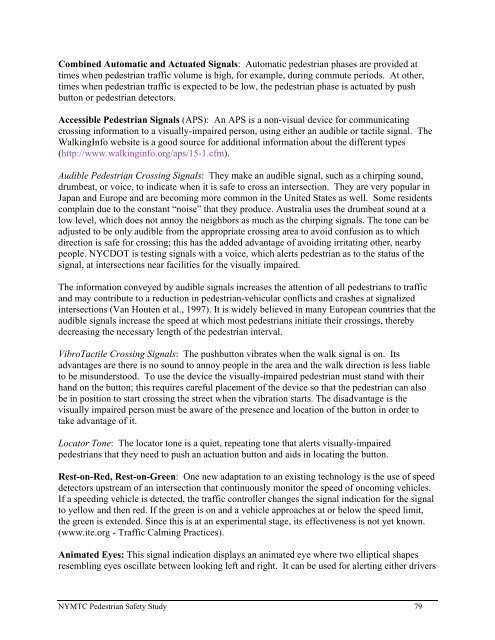NYMTC Regional Pedestrian Safety Study - New York Metropolitan ...
NYMTC Regional Pedestrian Safety Study - New York Metropolitan ...
NYMTC Regional Pedestrian Safety Study - New York Metropolitan ...
Create successful ePaper yourself
Turn your PDF publications into a flip-book with our unique Google optimized e-Paper software.
Combined Automatic and Actuated Signals: Automatic pedestrian phases are provided at<br />
times when pedestrian traffic volume is high, for example, during commute periods. At other,<br />
times when pedestrian traffic is expected to be low, the pedestrian phase is actuated by push<br />
button or pedestrian detectors.<br />
Accessible <strong>Pedestrian</strong> Signals (APS): An APS is a non-visual device for communicating<br />
crossing information to a visually-impaired person, using either an audible or tactile signal. The<br />
WalkingInfo website is a good source for additional information about the different types<br />
(http://www.walkinginfo.org/aps/15-1.cfm).<br />
Audible <strong>Pedestrian</strong> Crossing Signals: They make an audible signal, such as a chirping sound,<br />
drumbeat, or voice, to indicate when it is safe to cross an intersection. They are very popular in<br />
Japan and Europe and are becoming more common in the United States as well. Some residents<br />
complain due to the constant “noise” that they produce. Australia uses the drumbeat sound at a<br />
low level, which does not annoy the neighbors as much as the chirping signals. The tone can be<br />
adjusted to be only audible from the appropriate crossing area to avoid confusion as to which<br />
direction is safe for crossing; this has the added advantage of avoiding irritating other, nearby<br />
people. NYCDOT is testing signals with a voice, which alerts pedestrian as to the status of the<br />
signal, at intersections near facilities for the visually impaired.<br />
The information conveyed by audible signals increases the attention of all pedestrians to traffic<br />
and may contribute to a reduction in pedestrian-vehicular conflicts and crashes at signalized<br />
intersections (Van Houten et al., 1997). It is widely believed in many European countries that the<br />
audible signals increase the speed at which most pedestrians initiate their crossings, thereby<br />
decreasing the necessary length of the pedestrian interval.<br />
VibroTactile Crossing Signals: The pushbutton vibrates when the walk signal is on. Its<br />
advantages are there is no sound to annoy people in the area and the walk direction is less liable<br />
to be misunderstood. To use the device the visually-impaired pedestrian must stand with their<br />
hand on the button; this requires careful placement of the device so that the pedestrian can also<br />
be in position to start crossing the street when the vibration starts. The disadvantage is the<br />
visually impaired person must be aware of the presence and location of the button in order to<br />
take advantage of it.<br />
Locator Tone: The locator tone is a quiet, repeating tone that alerts visually-impaired<br />
pedestrians that they need to push an actuation button and aids in locating the button.<br />
Rest-on-Red, Rest-on-Green: One new adaptation to an existing technology is the use of speed<br />
detectors upstream of an intersection that continuously monitor the speed of oncoming vehicles.<br />
If a speeding vehicle is detected, the traffic controller changes the signal indication for the signal<br />
to yellow and then red. If the green is on and a vehicle approaches at or below the speed limit,<br />
the green is extended. Since this is at an experimental stage, its effectiveness is not yet known.<br />
(www.ite.org - Traffic Calming Practices).<br />
Animated Eyes: This signal indication displays an animated eye where two elliptical shapes<br />
resembling eyes oscillate between looking left and right. It can be used for alerting either drivers<br />
<strong>NYMTC</strong> <strong>Pedestrian</strong> <strong>Safety</strong> <strong>Study</strong> 79
















